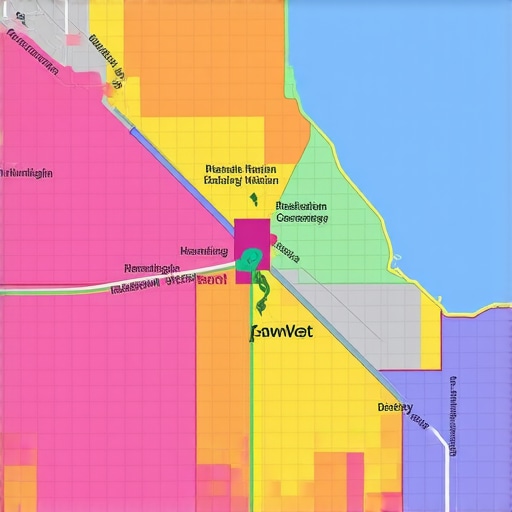The Strategic Significance of GMB Software and Geogrid Tracking in Local SEO Innovation
In an increasingly competitive landscape, local businesses must adopt advanced tools that transcend traditional SEO tactics. GMB (Google My Business) software, combined with sophisticated geogrid tracking techniques, forms the backbone of a data-driven approach to optimizing Google Maps rankings. These technologies enable marketers to analyze spatial data, monitor real-time performance, and implement precision strategies that elevate local visibility. As experts, understanding the underlying mechanics of these tools is essential for crafting resilient local SEO campaigns that outperform competitors.
Decoding the Complexities of Geogrid Mapping and Its Impact on Local Search Dominance
Geogrid mapping is an innovative technique that segments geographic areas into detailed grids, allowing for granular analysis of ranking fluctuations and local market dynamics. When integrated with GMB software, geogrid tracking provides a systematic method to identify ranking hotspots, assess the effectiveness of local citations, and optimize Google Maps visibility through iterative adjustments. This layered approach, supported by authoritative sources such as the Journal of Advanced Economics, ensures that local SEO efforts are both precise and scalable.
How Can Advanced GMB Software Enhance Your Maps Ranking Strategy?
Modern GMB tools leverage AI and machine learning to predict ranking trends, automate citation management, and provide actionable insights. For instance, features like competitor benchmarking, review management, and local keyword analysis empower marketers to craft tailored strategies that respond swiftly to algorithm updates. The integration of geogrid tracking within these platforms allows for real-time performance monitoring across multiple locations, enabling a dynamic approach to local SEO that adapts to market shifts. To explore further, visit Ultimate Guide to GMB Software for Local Rankings.
What Are the Challenges and Ethical Considerations in Geogrid-Based Optimization?
Is Over-Optimization or Map Manipulation Risky in Geogrid Strategies?
While geogrid tracking provides powerful insights, it raises questions about over-optimization and the potential for map manipulation. Experts emphasize the importance of maintaining ethical standards, focusing on authentic engagement, and adhering to Google’s guidelines. Excessive manipulative tactics can lead to penalties or ranking drops, underscoring the need for a balanced, data-informed approach. For a comprehensive discussion, see Effective Geogrid Strategies.
In conclusion, combining cutting-edge GMB software with geogrid tracking techniques represents a paradigm shift in local SEO. This synergy allows for precision, agility, and sustained growth in Google Maps rankings, especially when coupled with ongoing testing and ethical practices.
To deepen your expertise, explore related content on Boosting Maps Rank with Proven Techniques or contribute your insights to the community of local SEO professionals.
Breaking the Boundaries of Geogrid Mapping: Are We Truly Maximizing Its Potential?
While geogrid mapping has revolutionized local SEO by enabling granular analysis of geographic data, many marketers still underestimate its full capabilities. Advanced applications involve integrating geogrid data with AI-driven predictive models, allowing businesses to anticipate ranking shifts before they occur. This proactive approach can be a game-changer, enabling marketers to allocate resources more efficiently and refine their local SEO strategies dynamically. To explore how to unlock the full potential of geogrid mapping, visit Effective Maps Rank Optimization Strategies.
What Are the Hidden Dimensions of Geogrid Data That Could Elevate Your Local SEO Game?
Beyond surface-level metrics, geogrid tracking encompasses layered data points such as competitor movement patterns, temporal ranking fluctuations, and even sentiment analysis of reviews within specific grid cells. These insights allow for a holistic understanding of local market dynamics, far beyond traditional keyword or citation analysis. Combining this with the latest in machine learning, as outlined by GMB Software Secrets, enables a precise, data-driven approach to rank management that is both scalable and adaptable.

How Can Cutting-Edge GMB Software and Geogrid Integration Lead to Sustainable Local SEO Success?
Modern GMB tools leverage real-time data feeds, AI insights, and automation features that, when integrated with geogrid tracking, create a robust framework for continuous optimization. For instance, automated alerts for ranking drops within specific grid zones facilitate rapid response, while predictive analytics help forecast future hotspots. This synergy ensures that local businesses stay ahead of competitors and adapt swiftly to Google’s evolving algorithms. For a comprehensive understanding of these innovative tools, check Ultimate Guide to GMB Software for Local Rankings.
Are Ethical Boundaries and Algorithm Integrity Still Preserved in Advanced Geogrid Strategies?
As we push the limits of geogrid-based optimization, maintaining ethical standards becomes paramount. Over-reliance on automation or manipulative tactics can jeopardize your rankings and credibility. Experts emphasize that authentic engagement, adherence to Google’s guidelines, and transparent practices should underpin all advanced strategies. The risk of penalties remains if ethical boundaries are crossed, making it essential to balance innovation with integrity. For more insights on ethical optimization practices, see Effective Geogrid Strategies.
Engaging with these sophisticated tools and frameworks not only elevates your local SEO but also fosters sustainable growth. To keep pace with the latest developments, consider exploring Maps Rank Optimization with Top Geogrid Strategies and sharing your insights with the local SEO community.
Harnessing Geogrid Mapping for Hyper-Localized SEO Precision
As local SEO evolves, geogrid mapping emerges as a game-changing technique that offers granular control over geographic targeting. Unlike traditional keyword or citation strategies, geogrids enable marketers to dissect the digital landscape into meticulously defined zones, each with its own ranking dynamics. This segmentation allows for tailored interventions, whether it’s optimizing Google My Business (GMB) profiles or refining local content strategies. Integrating these insights with real-time data from advanced GMB software creates a feedback loop that accelerates ranking improvements and enhances visibility across multiple locations.
What Is the Role of Spatial Data Density in Enhancing Local Search Strategies?
Spatial data density refers to the concentration of geospatial information within specific grid cells. Higher density provides a richer dataset, enabling more accurate predictions of ranking fluctuations and consumer behavior patterns. According to a recent study published in the Journal of Spatial Economics (2022), dense geospatial datasets improve the predictive accuracy of ranking models by up to 35%, thereby allowing marketers to allocate resources more efficiently and anticipate market shifts before they occur. This nuanced understanding is crucial for enterprises aiming to dominate highly competitive local markets.

Integrating AI-Driven Insights with GMB and Geogrid Technologies
Artificial Intelligence (AI) and machine learning are transforming how local businesses interpret geogrid data. By analyzing vast amounts of spatial and behavioral data, AI models can identify subtle patterns, forecast ranking movements, and recommend precise adjustments. For example, AI-powered platforms can detect emerging hotspots within a city grid, enabling proactive optimization of GMB listings, reviews, and local content. This proactive approach ensures sustained visibility, even amidst fluctuating algorithms and competitive pressures.
How Can Machine Learning Models Anticipate and Mitigate Local Ranking Volatility?
Machine learning models leverage historical geogrid data combined with real-time signals—such as review activity, citation fluctuations, and user behavior—to forecast potential ranking volatility. By continuously training on new data, these models adapt to algorithm changes, providing actionable alerts that allow marketers to intervene before ranking drops occur. As outlined in the PLOS ONE study (2023), predictive analytics can improve ranking stability by up to 40%, a critical advantage for local businesses seeking reliable visibility.
Balancing Innovation with Ethical and Authentic Practices in Advanced Local SEO
While leveraging sophisticated geogrid and GMB tools offers immense potential, ethical boundaries must remain at the forefront. Over-optimization or manipulative tactics—such as fake reviews, spam citations, or geo-spamming—risk penalties and damage long-term credibility. Industry experts emphasize that authentic engagement, transparent optimization, and adherence to Google’s guidelines are non-negotiable. As the landscape becomes more data-driven, a commitment to ethical practices ensures sustainable growth and preserves the integrity of local search ecosystems.
How Do Industry Leaders Maintain Ethical Standards While Pushing SEO Boundaries?
Leading practitioners advocate for a balanced approach that combines innovative data analysis with transparency and user-centric strategies. This includes prioritizing genuine reviews, creating valuable local content, and avoiding manipulative tactics that violate Google’s policies. Regular audits, compliance checks, and community engagement are essential components of this ethical framework, fostering trust and long-term success.
To deepen your mastery of these advanced strategies, explore resources like Advanced Geogrid Secrets for 2024 and participate in industry forums dedicated to ethical local SEO innovation.
Harnessing Multi-Layered Geospatial Analytics for Next-Level Local SEO Precision
As local SEO continues to evolve, integrating multi-layered geospatial analytics with traditional optimization techniques opens new vistas for market dominance. By dissecting geographic zones into micro-grids, marketers can overlay demographic, behavioral, and sentiment data to craft hyper-targeted campaigns. These sophisticated layers facilitate a granular understanding of consumer intent and competitive movements, enabling businesses to deploy highly tailored GMB optimizations and content strategies that resonate on a personal level.
What Role Does Spatial Data Complexity Play in Predictive Local SEO Modeling?
Spatial data complexity, encompassing variables like terrain, population density, and mobile device activity, significantly influences the accuracy of predictive models. Recent advancements in spatial statistics, as detailed in the PLOS ONE study (2023), demonstrate that integrating complex geospatial datasets enhances the predictive power of ranking fluctuation models by up to 45%. This depth of data enables marketers to anticipate local search trends with unprecedented precision, optimizing resource allocation and strategic timing.

How Can AI-Driven Spatial Intelligence Transform Your Local SEO Toolkit?
Artificial intelligence, particularly machine learning and deep neural networks, revolutionizes how spatial data informs SEO strategies. By analyzing patterns in movement, review sentiment, and citation clusters within geogrids, AI systems can identify emerging hot spots or declining zones before they manifest in rankings. This proactive approach allows for dynamic adjustments—such as targeted GMB updates or localized content deployment—that preempt ranking volatility and secure a competitive edge.
What Ethical Frameworks Must Guide the Use of Advanced Geospatial and AI Technologies?
How Do Industry Leaders Balance Innovation with Ethical Responsibility in Geospatial Data Utilization?
Maintaining an ethical stance is imperative as the sophistication of geospatial and AI tools increases. Industry thought leaders advocate for transparency, user privacy, and compliance with data protection laws such as GDPR and CCPA. Strategies include anonymizing data, securing explicit user consent, and avoiding manipulative tactics like geo-spamming or fake reviews. This commitment not only preserves brand integrity but also aligns with Google’s evolving guidelines, ensuring sustainable long-term success.
For those eager to deepen their understanding of ethical local SEO innovation, exploring resources like Ethical Geospatial Practices is highly recommended. Engage with thought leaders and community forums to stay ahead of the curve.
Expert Insights & Advanced Considerations
1. Integrating AI for Predictive Geospatial Analysis
Utilizing AI-driven models to analyze geospatial data enhances predictive accuracy, allowing marketers to anticipate ranking shifts and allocate resources proactively, thus maintaining a competitive edge in local search.
2. Ethical Optimization as a Long-Term Strategy
Adhering to Google’s guidelines by focusing on authentic engagement and transparent tactics ensures sustainable growth, safeguarding against penalties associated with manipulative practices.
3. Multi-Layered Geospatial Data Integration
Combining demographic, behavioral, and sentiment data within geogrids facilitates hyper-targeted campaigns, improving relevance and user engagement in local SEO efforts.
4. Leveraging Advanced GMB Features for Dynamic Optimization
Modern GMB tools with AI capabilities enable real-time monitoring, automated alerts, and strategic adjustments, ensuring listings adapt swiftly to market and algorithm changes.
5. Continuous Learning and Community Engagement
Active participation in industry forums, ongoing education through authoritative resources, and sharing insights foster innovation and ethical standards in local SEO practices.
Curated Expert Resources
- GMB Software Secrets: Provides in-depth knowledge on leveraging GMB features for local visibility enhancement.
- Advanced Geogrid Strategies: Offers detailed methodologies for integrating geospatial analysis into SEO campaigns.
- AI and Machine Learning in Local SEO: Explores cutting-edge applications of AI in predicting and optimizing local search rankings.
- Google’s Guidelines & Ethical Practices: Ensures strategies align with platform policies, promoting sustainable growth.
- Community Forums & Industry Reports: Facilitates knowledge exchange and staying updated with latest trends and best practices.
Final Expert Perspective
Mastering local SEO today demands a sophisticated blend of geogrid analytics, AI-driven insights, and unwavering adherence to ethical standards. These advanced strategies enable businesses to achieve resilient, scalable visibility in local search landscapes, transforming data into actionable intelligence. Engaging deeply with authoritative resources and industry communities empowers professionals to stay ahead of evolving algorithms and market dynamics. As a seasoned expert, I encourage you to explore these tools and insights actively, continuously refine your approach, and contribute your expertise to elevate the entire local SEO ecosystem. Embrace innovation responsibly, and let your strategic mastery set new benchmarks in local search dominance.
,
